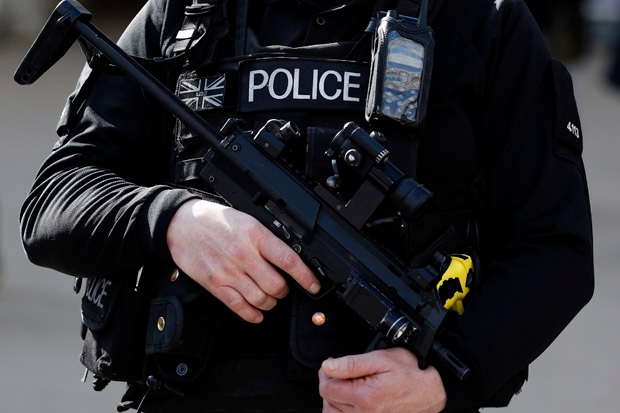To the casual glance it looks like a normal police car — same markings, same lights, same faces at the wheel. Only the two small yellow circles, one at each of the top corners of the windscreen, tell you that this is a mobile armoury. It will often be a BMW X5: a SUV’s suspension copes better with the weight of the weapons, the gun safe, the ballistic shields. Inside, the occupants will be wearing Glock 17 pistols and have access to weapons which could include, in ascending order of bullet size and ‘penetrative power’, the Benelli Super 90 shotgun, Heckler & Koch MP5 submachine gun, the G36 carbine, the Sig Sauer automatic gas-piston operated rifle, and the G3 sniper and assault rifle.
The MP5 is the standard; hollow-point rounds are used to prevent ‘over-penetration’; that is, bullets passing through a target or wall and hitting a bystander. The police use the single-shot or semi-automatic version: automatics are largely reserved for the SAS, though this may be changing.
Pictures of the Met’s specialised firearms squad, SCO19, in their masks, helmets, boilersuits and weaponry, underline how far we have come from the days when a single, unarmed constable guarded No. 10. Yet the truth is that there are far fewer Robocops than you’d think. Until the Paris attacks, the number of armed police officers in England and Wales was falling sharply. Home Office figures from 2014 show there were 5,875, down more than a thousand since 2008. London, often seen as the main terrorist target, had 2,211 firearms-trained officers, down from almost 2,800 over the same period. Some county forces had as few as 35. Surrey, full of army bases and other potential targets, had only 48 authorised firearms officers.
The majority of these officers will not be on duty at any one time. Not all of them will be routinely armed, even when they are on duty. And the vast majority will be trained and used only for the ‘bread and butter’ gun work of dealing with armed criminals. (The sharp fall in gun crime — in 2014, armed police fired lethal weapons only twice in anger — explains the drop in their numbers.)
Only the tiniest fraction of firearms officers are the elite ‘counter-terrorist specialist firearms officers’ — the guys with the G36s, trained for Paris-style hostage situations, marauder attacks and sieges. In London there are currently 130 such officers, about 6 per cent of the Met’s total armed strength. The number in even the largest provincial forces is understood to be minute.
It is those numbers, particularly in the provinces, which the authorities are now racing to increase. But for the foreseeable future, as Simon Chesterman, firearms lead for the National Police Chiefs’ Council, admitted last year, ‘a series of no-notice attacks…would significantly stretch our armed resources and very quickly we would be asking for military support’.
Detachments of the SAS and SBS are on permanent standby at army barracks in London: they, too, may carry out mobile patrols. The army is buying them the Osprey V-22, a combination helicopter-plane that can take off and land like a helicopter but travel at the speed of an aircraft.
It is hard to argue that any of this is unnecessary. What’s more troubling is the stealthy leakage of militarised policing, and military-looking policemen, into everyday operations. Plod’s new favourite weapon is the electric-shocking Taser, described as ‘non-lethal’, though in fact several people have been killed by it.
Thousands of officers all over Britain are now routinely armed with Tasers, including (among others) neighbourhood police in that notorious hotbed of violence, Cambridge. The weapons were used 10,000 times in 2014, an increase of more than 40 per cent in four years, even though there is no evidence whatever that crime, or violence against the police generally, increased in that time. It’s all rather a long way from Dock Green.





Comments